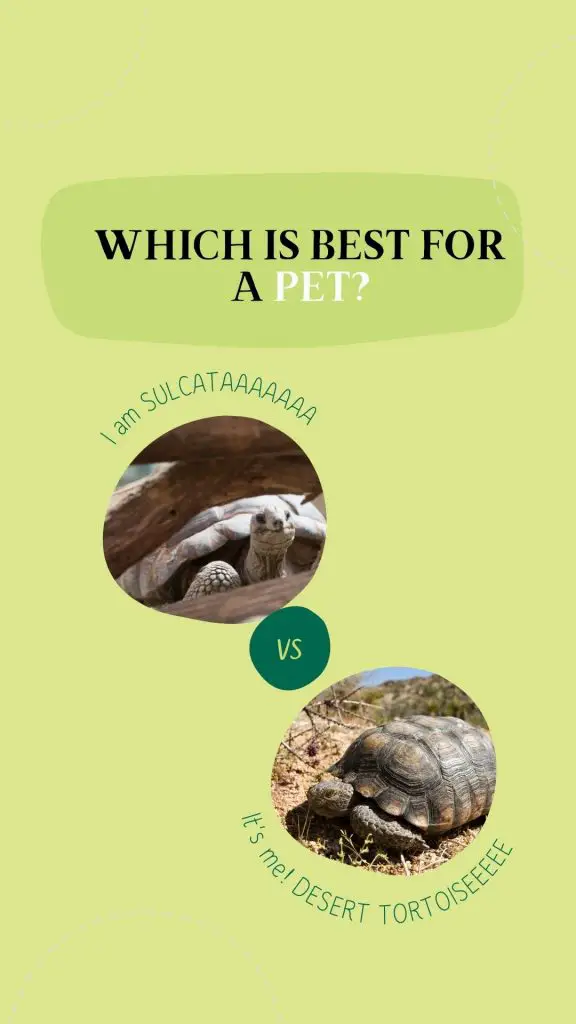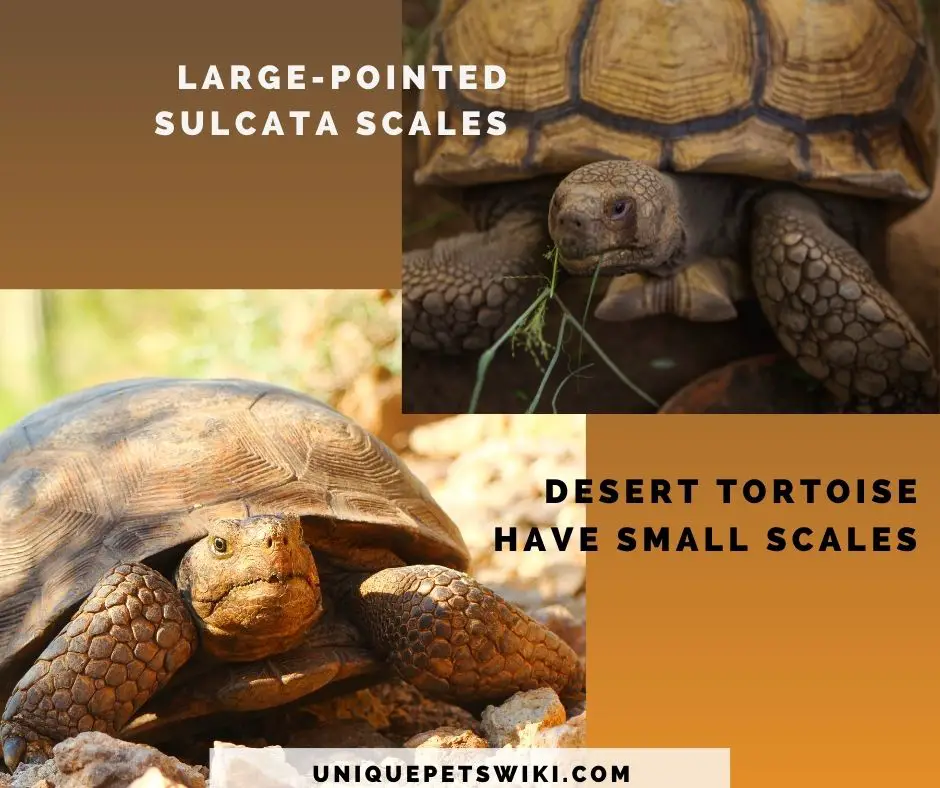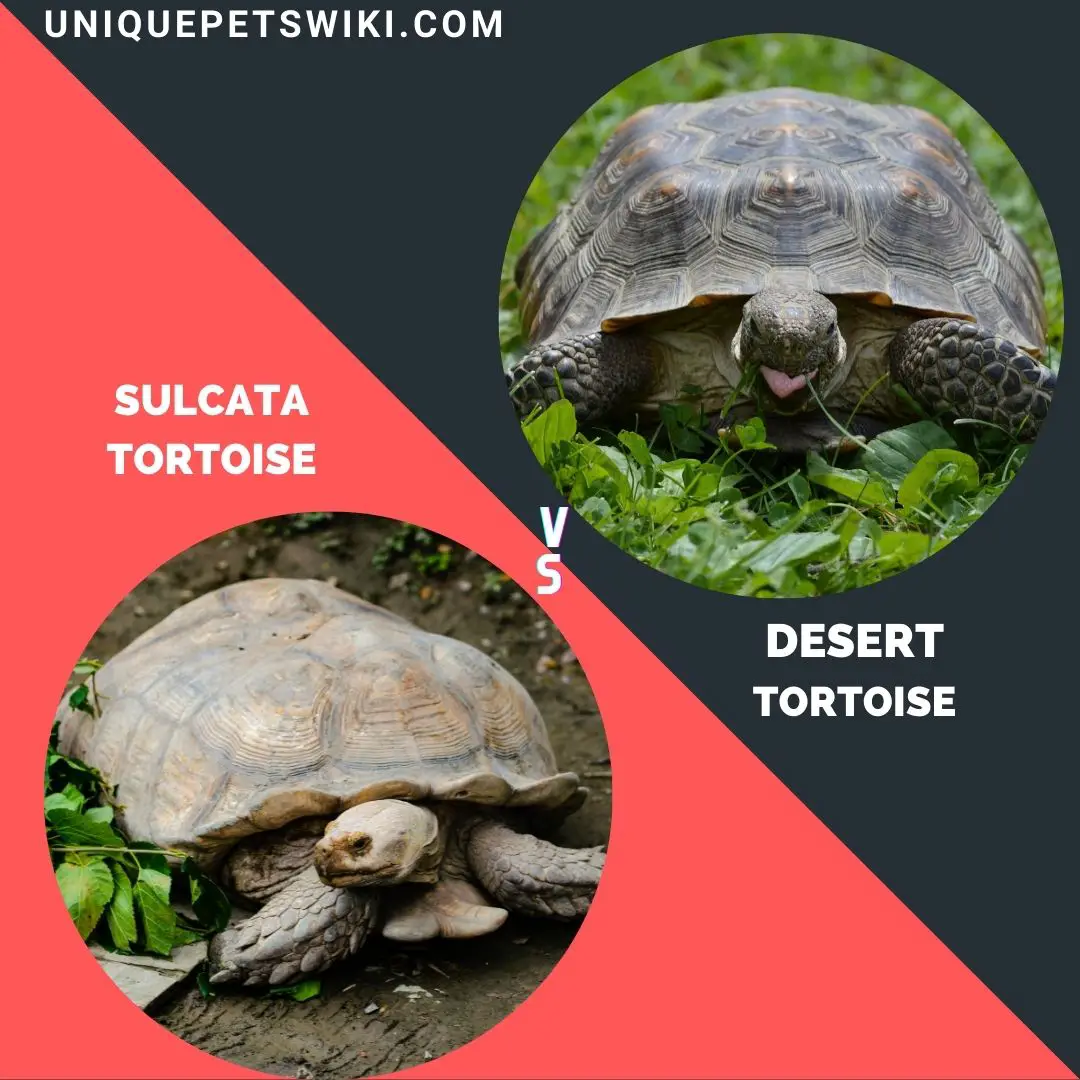Owning a wild pet can be euphoric but also challenging. Unlike domestic pets like cats and dogs, wild pets require special care and commitment. Hence, it is critical to learn more about your pet before bringing them home.
Most tortoise enthusiasts experience difficulties in deciding which species would be best for them as beginners. As such, we came up with this article to help you compare the famous sulcata and desert tortoises.
In this article, we will tell you everything you need to know about sulcata and desert tortoises. You will also be able to judge which of the two tortoises would be the best for you even though you are a beginner.
Remember they say, “Confidence is ignorance. If you’re feeling cocky, it’s because there’s something you don’t know.” Let’s grab that knowledge!
Contents
Sulcata vs. Desert Tortoises as Pets
Sulcata and desert tortoises make wonderful pets. And, they both have similar physical traits, especially when they are young. As they get older, their differences become obvious, especially when it comes to their sizes.
Sulcata tortoises originate from Africa, while desert tortoises are natives to the United States. The purpose of this article is to help you understand the two tortoises, compare, and pick whichever suitable for you.
Sulcata vs. desert Tortoises: Full Comparison

There are several factors that you must consider when choosing the best pet for you. These factors help you understand and weigh what works best depending on manageability, attraction, availability, and sustainability.
In this section, we are going to compare sulcata and desert tortoises regarding those factors. We aim to help you pick from the two and prepare you for what to expect from your chosen tortoise.
Let’s jump to those factors!
Lifespan
We must agree that owning a pet, and especially a wild pet is a big responsibility that comes with consequences. As a result, it is necessary to understand how long you are expected to live with your pet.
Some people prefer pets with a longer lifespan, while others do not like to commit to long-term responsibility.
Tortoises are known to have a slow metabolism that makes them have a longer lifespan. Therefore, any tortoise enthusiast must prepare to live with these pets for a couple of years.
However, some species have a longer lifespan than others. In this case, sulcata tortoises beat the desert tortoises.
While sulcata tortoises can live for more than 100 years, desert tortoises live for 50 years or more in captivity.
Habitat
Sulcata tortoises originate from southern Saharan, in Africa. They live in the arid deserts of Mauritania, Chad, Niger, Sudan, Mali, and Senegal.
The climate in these areas is harsh, and thus, sulcata tortoises dig large tunnels to hide from the scorching sun.
In captivity, it is inevitable to provide a similar habitat. Therefore, you should ensure adequate heating and lighting to match your pet’s climate in the wild.
Additionally, the substrate should be dry and easy to dig. The enclosure should also be large enough to hold the fast-growing sulcata tortoise.
Desert tortoises are natives to Mojave and Sonoran deserts. Even though they also live in deserts, they spend 95% hidden underground.
Just like the sulcatas, they live in rocky areas. However, they live near sea levels that are 3500 feet above sea level.
Size
Size is one of the major factors that differentiate sulcata and desert tortoises. However, when the two tortoises are young, it isn’t easy to distinguish them as they share similar physical traits.
When they are older, their body size becomes obvious as sulcatas grow faster and become massively large. The size of an adult sulcata tortoise is 30-35 inches.
On the other hand, desert tortoises are relatively small as they only get to a maximum size of 14 inches when fully grown.
Weight
Weight is also a major difference between sulcata and desert tortoises. Just like their size, their weight is also magnificently different when they are adults.
Sulcatas can weigh anything between 150- 200 pounds when fully grown. How much a sulcata is likely to get bigger depends on the species and a specific tortoise.
For instance, two sulcata tortoises living together and fed the same amount of food can have a major size and weight difference.
Contrarily, desert tortoises don’t weigh much even when they are fully grown. The average weight of a desert tortoise is 8 – 15 pounds.
Looks
Sulcata and desert tortoises look physically alike, especially when they are young. They are both tan and share a major similarity.
Even though it’s easy to differentiate them when they are older because of their size, when they are young, it isn’t easy.
However, they do have some physical differences that you can observe to differentiate them.
These physical differences include
Spurs
Sulcata tortoises have large pointed scales on their front legs, while desert tortoise’s scales are small.

Nuchal Scute
Sulcatas only have a deep V where their right and left marginal scutes join, unlike the desert tortoises that have nuchal scutes separating their marginal scutes.
Carapace
Sulcata tortoises have a notched rear carapace with wavy edges when they are young. On the contrary, desert tortoises’ carapaces have smooth edges.
Active Level
Sulcata tortoises are heavy eaters. As such, they are quite active and can spend hours in the field while grazing.
Differently, desert tortoises spend 95% of their time hiding underground. They only become active after seasonal rains.
Diet
Sulcata and desert tortoises are herbivores. Their major diets include grasses, flowers, fruits, and weeds.
However, unlike sulcatas, desert tortoises do not have teeth and thus grind their food using their beak.

Additionally, it takes desert tortoises 20-30 days to digest their food. Since most of their available diet, such as cactus, contains a high water percentage, they can go for up to one year without drinking water.
Brumation
Sulcata tortoises can still get active during the cold seasons. Thus, they do not brumate during winter, but they become less active and only eat a little.
However, as for the desert tortoises, they hibernate during the winter seasons. Their hibernation starts as soon as the temperature goes below 600 usually, between October and early March.
Personality
Sulcata tortoises are popular among tortoise enthusiasts. They are known to have a unique personality that’s almost similar to dogs. They are docile, friendly, and calm.
On the contrary, desert tortoises are bold-shy, exploratory, and calm. The good thing about the desert tortoises is that you can still handle them even when they are older due to their size.
Required Enclosure Size
Sulcata tortoises can be quite expensive when it comes to housing. These magnificent tortoises require a large enclosure when they are older to contain their size.
The minimum size of an enclosure that an adult sulcata requires is no less than 18 feet.
In contrast, desert tortoises are pretty small. Thus, their tank does not have to be overly big. A 20-gallon tank should be enough to keep an adult desert tortoise.
Lighting, Heating, Humidity, Requirements
Wild pets require a habitat that is similar to their natural environment to thrive in captivity. It is critical to adjust lighting, heating, and humidity to mimic sulcata and desert tortoise’s natural environment.
Even though they live in the deserts, their natural environment is different. Even so, they both require a thermogradient setting in their enclosure.
Therefore, you should provide a basking spot and one cooling side for both tortoises.
The basking spot for sulcata tortoise should be 100-1000 F and a cooling temperature of 77-950 F.
Desert tortoises require a temperature ranging between 70-750 F and 95-1000 F at the basking spot.
Lighting is also significant for both tortoises. UVB is critical to help the tortoises synthesize Vitamin D. You can either let them stay outdoors for 30 minutes a day or provide a UVB bulb in their enclosure.
The average humidity for sulcata tortoises should be 40-60%, while desert tortoises require 30-40% humidity.
Sustainability for Beginners
Both tortoises’ sustainability requirements are similar, except that it would require you a bigger enclosure to keep an adult sulcata.
However, even though desert tortoises are small, they too come with disadvantages such as availability.
It is illegal to transport desert tortoises from the United States, and thus they may be unavailable to people living outside the States.
Costs
Desert tortoises have been listed as endangered species. Thus, it is illegal to collect a wild desert tortoise.
Even so, you can adopt one using Phoenix adoption program. Adopting one can be free. However, you may have to donate at least $25 and also prove that you can adequately care for the tortoise.
Sulcata tortoises, on the other hand, are readily available. But, their enclosure and huge appetite make them expensive to sustain. The approximate cost of a sulcata tortoise is $300-1000 depending on age and size.
Availability to Keep in Groups
Sulcata tortoises can be kept in groups. Even so, you must be ready to spend more on housing them as they require even larger tanks to accommodate them together.
However, as for the desert tortoises, it is inadvisable to keep them in groups. The California Department of Fish and Wildlife discourages breeding desert tortoises in captivity.
Can you Keep Sulcata and Desert Tortoise Together?
Housing two different species of tortoises together is inadvisable. Desert and sulcata tortoises have different temperature and humidity requirements.
As such, keeping them together may not be possible. There have been reports of desert tortoises dying of respiratory diseases after being housed together with sulcata tortoises.
Wrapping Up
In this article, we have discussed the basic requirements of sulcata and desert tortoises. We have also given you the similarity between the two. And, as of now, you are familiar with both tortoises.
It is up to you to choose whichever sounds or feels better to you. sulcata vs. desert tortoise, what’s your pick? Let us know in the comment area below!
